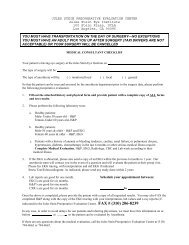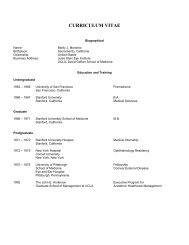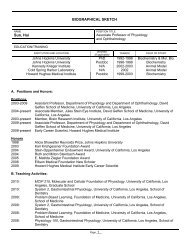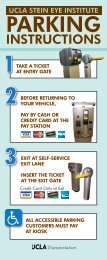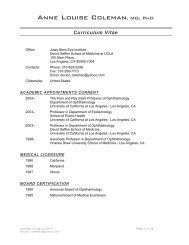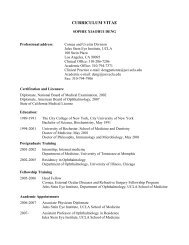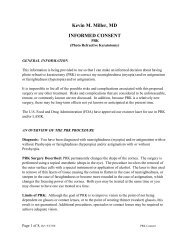ucla laser refractive center informed consent
ucla laser refractive center informed consent
ucla laser refractive center informed consent
You also want an ePaper? Increase the reach of your titles
YUMPU automatically turns print PDFs into web optimized ePapers that Google loves.
GENERAL INFORMATION<br />
UCLA LASER REFRACTIVE CENTER<br />
INFORMED CONSENT<br />
LASER ASSISTED IN SITU KERATOMILEUSIS<br />
(LASIK)<br />
The following information is intended to help you make an <strong>informed</strong> decision about having<br />
Laser Assisted In Situ Keratomileusis (LASIK) surgery.<br />
It is impossible to list all of the possible risks and complications associated with this proposed<br />
surgery or any other treatment. Risks and complications that are considered to be unforeseeable,<br />
remote, or commonly known are not discussed. In addition, because LASIK is a relatively new<br />
surgery, there may be long-term effects not yet known or anticipated at the present time.<br />
The U.S. Food and Drug Administration (FDA) have approved our excimer <strong>laser</strong> for use in<br />
LASIK, for the treatment of myopia (nearsightedness) with/without astigmatism or hyperopia<br />
(farsightedness) with/without astigmatism. LASIK combines two procedures: Automated<br />
Lamellar Keratoplasty (ALK) and Photo<strong>refractive</strong> Keratectomy (PRK).<br />
AN OVERVIEW OF THE LASIK PROCEDURE<br />
Diagnosis: You have been diagnosed with myopia (nearsightedness) with/without astigmatism<br />
or hyperopia (farsightedness) with/without astigmatism.<br />
LASIK Surgery Described: LASIK permanently changes the shape of the cornea. The<br />
surgery is performed using a topical anesthetic (drops in the eye). The procedure involves<br />
folding back a thin layer of corneal tissue (corneal flap). ). The corneal flap is created with an<br />
instrument called a microkeratome or a femtosecond <strong>laser</strong>. The femtosecond <strong>laser</strong> creates the<br />
flap by producing tiny bubbles inside the cornea that are 1/10,000 of an inch in diameter. (The<br />
<strong>laser</strong> beam cannot penetrate into the eye beyond the cornea.) Once the flap has been made, a<br />
thin layer of corneal tissue is removed with the light from an excimer <strong>laser</strong>. After removal, the<br />
flap is replaced and bonds back into place, usually without the need for stitches. The removal of<br />
thin layers of tissue causes the <strong>center</strong> of the cornea to flatten in the case of nearsightedness, or<br />
steepen in the case of farsightedness or become more rounded in the case of astigmatism, which<br />
changes the focusing power of the cornea.<br />
Limits of LASIK: Although the goal of LASIK is to improve vision to the point of not being<br />
dependent on glasses or contact lenses, or to the point of wearing thinner (weaker) glasses, this<br />
result is not guaranteed. Additional procedures, spectacles or contact lenses may be required to<br />
achieve adequate vision. LASIK surgery will not prevent you from developing naturally<br />
occurring eye problems such as glaucoma, cataracts, or retinal degeneration or detachment.<br />
Page 1 of 8, Rev 08/14/06 I have read and understand this page. Patient Initials ______
LASIK does not correct the condition known as presbyopia (aging of the eye), which occurs in<br />
most people around age 40 and requires them to wear reading glasses for close-up work,<br />
sometimes including computer distance. The key question you must ask yourself is: Can you<br />
read up close while looking through the TOP part of your distance glasses? If you must take off<br />
your distance glasses or use bifocals to read up close, then you have presbyopia. Patients with<br />
presbyopia who get both eyes fully corrected for distance vision will then need to use reading<br />
glasses to seeing clearly up close, this sometimes includes computer distance. Therefore, if you<br />
presently need reading glasses, you will likely still need reading glasses after this treatment. If<br />
you do not need reading glasses because you take off your distance glasses to read, you will<br />
likely need reading glasses after this treatment if you have both eyes corrected fully for distance.<br />
If you do not need reading glasses now, you will need them at a later age. You may consider<br />
having one eye weighted for mid-range near vision. Many patients over the age 40 make this<br />
decision and are extremely pleased with both their distance and mid-range near vision (example:<br />
computer screen, shopping tags, seeing your food) and then use simple reading glasses for closerange<br />
and for smaller printed materials (example: newspapers, some magazines, road maps).<br />
Risks and Contraindications<br />
Contraindications: The treatment should not be performed on persons:<br />
• with uncontrolled vascular disease<br />
• with uncontrolled autoimmune disease;<br />
• who are immune-compromised or on drugs or therapy that suppress the immune system;<br />
• who are pregnant, nursing, or expecting to become pregnant within the six months following<br />
the LASIK procedure;<br />
• with residual, recurrent, or active ocular disease(s) or abnormality except for myopia<br />
with/with astigmatism, hyperopia with/without astigmatism or presbyopia in either eye;<br />
• with active or residual disease(s) likely to affect wound-healing capability;<br />
• with unstable or uncontrolled diabetes;<br />
• with progressive myopia or hyperopia;<br />
• with uncontrolled glaucoma<br />
• with uncontrolled dry eyes or blepharitis<br />
If you know that you have any of these conditions, you should inform your physician. In<br />
addition, if you have any other concerns or possible conditions that might affect your decision to<br />
undertake LASIK surgery, you should discuss them with your physician.<br />
Page 2 of 8, Rev 08/14/06 I have read and understand this page. Patient Initials ______
Risks: The risks of LASIK surgery include, but are not limited to:<br />
• Loss of Vision: LASIK surgery can possibly cause loss of best-corrected vision. This can be due to<br />
infection (internal or external), scarring or other causes. Unless successfully controlled by antibiotics,<br />
steroids, or other necessary treatment, it could even cause loss of the infected eye. Vision loss can be<br />
due to the cornea healing with an irregular surface, which could cause astigmatism and make wearing<br />
glasses or contact lenses necessary. Irregular cornea healing could result in an uneven corneal surface<br />
so that distorted vision or “ghosting” occurs. This may or may not be correctable by spectacles or<br />
contact lenses. . The femto-second <strong>laser</strong> or the excimer <strong>laser</strong> could malfunction, requiring the<br />
procedure to be stopped before completion. Depending on the type of malfunction, this may<br />
or may not be accompanied by visual loss.<br />
• Visual Side Effects: Other complications and conditions that can occur with LASIK<br />
surgery include: epithelial ingrowth (epithelial cells growing underneath the corneal flap);<br />
anisometropia (difference in power between the two eyes); aniseikonia (difference in<br />
imaging size between the two eyes); double vision; hazy vision; induced astigmatism;<br />
reduced contrast sensitivity; fluctuating vision during the day and from day to day; increased<br />
or decreased sensitivity to light that may be incapacitating for some time and may not<br />
completely go away; glare and halos around lights, which may not completely go away.<br />
There is a greater chance that the whites of my eyes may temporarily appear pink or red for<br />
several days to several weeks after surgery. This redness is more common with femtosecond<br />
-created flaps than with microkeratome-created flaps. Your vision after surgery using the<br />
IntraLase technology may not be clear immediately and you might not notice improvement<br />
for several days to several weeks.<br />
• Overcorrection or Undercorrection: It may be that LASIK surgery will not give you the<br />
result you desired. Some procedures result in the eye being undercorrected. If this occurs, it<br />
may be possible or necessary to have additional surgery to fine-tune or enhance the initial<br />
result. It is also possible that your eye may be overcorrected to the point of becoming<br />
farsighted (by over treating myopia) or nearsighted (by over treating hyperopia). It is<br />
possible that your initial results could regress over time. In some, but not all cases, retreatment,<br />
glasses or contact lenses could be effective in correcting vision. In some cases,<br />
even 90% clarity of vision is still slightly blurry. Retreatment surgeries can be performed<br />
when vision is stable UNLESS it is unwise or unsafe. Retreatment surgery can be performed<br />
no sooner than three months after surgery. Generally, the original flap can be re-lifted<br />
without creating a new flap. Rarely, a new flap may need to be created. A retreatment will<br />
only be considered if there is adequate corneal tissue. If there is inadequate tissue, it may not<br />
be possible to perform a retreatment. An assessment and consultation will be held with the<br />
surgeon at which time the benefits and risks of a retreatment surgery will be discussed.<br />
• Keratoconus: It is a degenerative corneal disease affecting vision that occurs in<br />
approximately 1/2000 in the general population. While there are several tests that suggest<br />
which patients might be at risk, this condition can develop in patients who have normal<br />
preoperative topography (a map of the cornea obtained before surgery) and pachymetry<br />
(corneal thickness measurement) . Since keratoconus may occur on its own, there is no<br />
absolute test that will ensure a patient will not develop keratoconus following <strong>laser</strong> vision<br />
correction. Severe keratoconus may need to be treated with a corneal transplant while mild<br />
keratoconus can be corrected by glasses or contact lenses.<br />
Page 3 of 8, Rev 08/14/06 I have read and understand this page. Patient Initials ______
• Other Risks: Other reported complications include corneal ulcer formation; clouding or<br />
hazing of the cornea; cornea scarring; endothelial cell loss (loss of cell density in the inner<br />
layer of the cornea, possibly resulting in corneal swelling); ptosis (droopy eyelid); corneal<br />
swelling; contact lens intolerance; increased dry eyes; blepharitis (inflammation of eyelids or<br />
scaly eyelids); rosacea (eyelid nodules); retinal detachment; new or increased floaters;<br />
hemorrhage; diminished depth perception; corneal epithelial (skin) abrasion or defect which<br />
can slow the recovery process and may lead to reoccurring corneal erosions with eye<br />
discomfort and blurred vision. Complications could also arise requiring further corrective<br />
procedures including either a partial (lamellar) or full-thickness corneal transplant using<br />
donor cornea. These complications include loss of corneal disc; damage to the corneal disc;<br />
disc decentration; progressive corneal thinning (ectasia). Sutures may also be required which<br />
could induce astigmatism. It is also possible that the microkeratome or the excimer <strong>laser</strong><br />
could malfunction and the procedure stopped. There are also potential complications due to<br />
anesthesia and medications that may involve other parts of your body. The <strong>laser</strong> may need to<br />
be aborted if an improper flap is created. If this occurs, LASIK may be attempted again after<br />
at least 3 months or another procedure may be used to attempt vision correction. Since it is<br />
impossible to state all potential risks of any surgery or procedure, this form does not provide<br />
a comprehensive listing of every conceivable problem. Prior to creating the flap the surgeon<br />
will test the outer layer of the cornea, epithelium, if this outer layer is loose the surgeon will<br />
need to change to a surface <strong>laser</strong> procedure (i.e. PRK or LASEK).<br />
If you have had previous eye surgery it is possible that during the procedure that the<br />
incisions could re-open. This could decrease the healing and lead to irregular healing. A<br />
contact lens may need to be worn as a bandage until the incisions close. In a rare case<br />
sutures may be required to close the incisions. In a very rare case a cornea transplant may be<br />
needed to restore useful vision.<br />
• Employment Risk: You should be aware that having this surgery may affect future<br />
employment opportunities with certain military or law enforcement agencies. This procedure<br />
may impair your ability to perform your job.<br />
• Later-Discovered Complications: LASIK is a relatively new technique. You should be<br />
aware that other complications might occur that have not yet been reported. Longer-term<br />
results may reveal additional risks and complications. After the procedure, you should<br />
continue to have routine check ups to assess the condition of your eyes.<br />
• Risks of Not Undergoing LASIK: The risks of not having the surgery are limited to those<br />
associated with your current visual condition. These include but are not limited to the<br />
dangers that may be associated with losing glasses or contact lenses, the risks of corneal<br />
distortion and/or infection from wearing contact lenses, and the risks of trauma to the eye<br />
caused by breakage of plastic spectacles or contact lenses in the eye.<br />
Alternatives to LASIK<br />
LASIK is purely an elective procedure, and you may decide not to have this operation at all.<br />
Among the alternatives are:<br />
• Eyeglasses/spectacles<br />
Page 4 of 8, Rev 08/14/06 I have read and understand this page. Patient Initials ______
• Contact lenses<br />
• Photo<strong>refractive</strong> keratectomy (PRK)<br />
• Radial Keratotomy (RK)<br />
• Automated lamellar keratoplasty (ALK)<br />
• Orthokeratology<br />
• Hexagonal keratotomy (HK)<br />
• Corneal relaxing incision (AK)<br />
You may wish to discuss these options with your physician.<br />
Cost of Post-Procedure Care: Costs for post-procedure, follow-up care, and LASIK corrective<br />
procedures for 1 (one) year are included in the cost of the LASIK procedure. Initial<br />
postoperative eye medications are included in the fee. Oral medications, artificial tears,<br />
ointments, and eye medications beyond the initial medications provided in your postoperative kit<br />
will need to be purchased by you at a pharmacy. Examinations not related to the normal followup<br />
schedule will be charged accordingly (i.e. eye injuries, eye infections, etc.).<br />
Pre- and Post-Treatment Care<br />
Before the LASIK Surgery<br />
• Pregnancy: Pregnancy could adversely affect your treatment result since your <strong>refractive</strong><br />
error can fluctuate during pregnancy; In addition, pregnancy may affect your healing process,<br />
and some medications may pose a risk to an unborn or nursing child. If you are pregnant, or<br />
expecting to become pregnant, you should not undergo the LASIK procedure until after the<br />
pregnancy. If you become pregnant in the six (6) months following treatment, you should<br />
notify your eye doctor immediately.<br />
• Taking medications and allergies: You should inform your physician of any medications<br />
you may be taking in order to account for the risk of allergic reactions, drug reactions, and<br />
other potential complications during the LASIK surgery and subsequent treatment.<br />
• Contact lens wearers: Patients who wear gas-permeable or hard contact lenses must<br />
completely stop wearing such lenses at least 3 weeks prior to the initial eligibility<br />
examination. (This period may be longer for some patients.) Patients who wear soft contact<br />
lenses must completely stop wearing their soft contact lenses at least 3 days prior to the<br />
eligibility examination. After the eligibility exam, you may wear your contacts up until 24<br />
hours prior to surgery.<br />
Post-Treatment Precautions:<br />
• Eye Protection: Avoid exposing the eye to tap water in the bath or shower, as such<br />
nonsterile water may expose the eye to increased risks of infection. Wear sunglasses during<br />
the first day after having surgery. The eye shield should be worn nightly for 1 week. Avoid<br />
rubbing the eye. The eye may be more fragile to trauma from impact. Evidence has shown<br />
that, as with any other scar, the corneal incision will not be as strong after healing as the<br />
original cornea was at the site of the incision. If you have astigmatic keratotomy (AK) to<br />
Page 5 of 8, Rev 08/14/06 I have read and understand this page. Patient Initials ______
correct astigmatism, it may weaken the eye as well. Therefore, the eye is somewhat more<br />
vulnerable to all varieties of injuries after LASIK, at least for the first year after surgery.<br />
You must wear protective eye wear when engaging in contact or racquet sports or other<br />
activities in which the possibility of a ball, projectile, elbow, fist or other traumatizing object<br />
contacting the eye may be high. No water skiing or jet skiing for 3 months after surgery.<br />
• Operating Motor Vehicles: After LASIK, in order to operate motor vehicles, glasses,<br />
contact lenses, eye drops, or other measures may be needed. After surgery, you may<br />
experience starburst-like images or “halos” around lights, your depth perception may be<br />
slightly altered, and image sizes may appear slightly different. Some of these conditions may<br />
affect your ability to drive and judge distances. Driving should only be done when you are<br />
certain that your vision is adequate. On the day of the LASIK procedure and for your 1 day<br />
postoperative appointment, you should arrange to have a driver.<br />
• Pain and Discomfort: The amount of pain and discomfort that can be expected soon after<br />
the LASIK procedure varies with the individual. You should expect that the eye will be sore<br />
to some extent after the surgery. Vision may be blurry, and you may experience some<br />
redness and/or corneal edema (swelling of the cornea). Some patients report the sensation of<br />
a foreign object in the eye, itching, or dryness of the eye.<br />
Patient Statement<br />
• I have read this Informed Consent form (or it has been read to me). The LASIK procedure<br />
has been explained to me in terms that I understand.<br />
• I understand that the LASIK procedure has been approved by the FDA for the treatment of<br />
myopia (nearsightedness) with/without astigmatism or hyperopia with/without astigmatism.<br />
• I have been <strong>informed</strong> about the possible benefits and possible complications, risks,<br />
consequences, and contraindications associated with LASIK. I understand that it is<br />
impossible for my doctor to inform me of every conceivable complication that may occur,<br />
and that because LASIK is a relatively new procedure, there may be unforeseen risks. I have<br />
been given the opportunity to ask questions and have received satisfactory answers to any<br />
questions I have asked. I understand that no guarantee of a particular outcome was given and<br />
that my vision could become better or worse following treatment.<br />
• My decision to undertake the LASIK procedure was made without duress of any kind. I<br />
understand that LASIK is an elective procedure, and my myopia or hyperopia and/or<br />
astigmatism may be treated by alternative means, such as spectacles, contact lenses, or other<br />
forms of <strong>refractive</strong> surgery. It is hoped that LASIK will reduce or possibly eliminate my<br />
dependence on glasses or contact lenses. I understand that the correction obtained may not<br />
be completely adequate and that additional correction with glasses or contact lenses may be<br />
needed.<br />
• I authorize the physicians and other health care personnel involved in performing my LASIK<br />
procedure and in providing my pre- and post-procedure care to share with one another any<br />
information relating to my health, my vision, or my LASIK procedure that they deem<br />
relevant to providing me with care.<br />
Page 6 of 8, Rev 08/14/06 I have read and understand this page. Patient Initials ______
• I have had sufficient time review this <strong>consent</strong> form. A physician or an associate has<br />
adequately addressed my questions and concerns. By signing below, I am making an<br />
<strong>informed</strong> decision to undergo the LASIK procedure. I have received a copy of this <strong>consent</strong><br />
for my own records.<br />
• I authorize the release of my medical records in order to process medical claims or requests<br />
for further information from insurance companies.<br />
• I understand that I have had an interpreter or legal guardian read this <strong>consent</strong> that they will<br />
sign under the surrogate <strong>consent</strong> area for me.<br />
• I understand that if I elect to have another physician and/or optometrist follow my<br />
postoperative care that I will sign the management <strong>consent</strong> area.<br />
I <strong>consent</strong> to have Dr. Kevin M. Miller perform LASIK on my:<br />
(circle one) right eye/ left eye/ both eyes.<br />
____________________________________<br />
Patient Name<br />
____________________________________ _______________________<br />
Patient Signature Date/Time<br />
____________________________________<br />
Witness Name<br />
____________________________________ _______________________<br />
Witness Signature Date/Time<br />
Page 7 of 8, Rev 08/14/06 I have read and understand this page. Patient Initials ______
FOR SURROGATE CONSENT<br />
I am the guardian, next-of-kin, or legal representative of the patient whose name appears above<br />
on the patient signature line. I have read and fully understand the foregoing information and have<br />
discussed this information and its terms with the patient to the extent of the patient’s<br />
understanding. Due to the patient’s inability to provide <strong>informed</strong> <strong>consent</strong>, I <strong>consent</strong> to have<br />
LASIK performed on the patient’s right eye/ left eye/ both eyes.<br />
_______________________________<br />
Name of Surrogate<br />
_______________________________ ____________________<br />
Surrogate Signature Date/Time<br />
_______________________________<br />
Nature of Relationship to Patient<br />
_______________________________<br />
Witness Signature<br />
MANAGEMENT CONSENT FORM<br />
It is my desire to have Doctor Kevin M. Miller perform my preoperative/postoperative followup<br />
care for <strong>refractive</strong> surgery. I have been assured that UCLA Laser Refractive Center will be<br />
contacted immediately if I experience any complications related to my eye surgery.<br />
Reason for Management by this doctor, is: (please check one)<br />
___ Maintain established eye care relationship.<br />
___ Difficult to return to UCLA for follow-up care because of location.<br />
___ Other (please give reason) _______________________________________________<br />
Patient Signature ________________________________Date_________________<br />
Witness Signature _______________________________Date_________________<br />
Page 8 of 8, Rev 08/14/06 I have read and understand this page. Patient Initials ______



